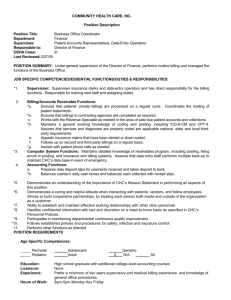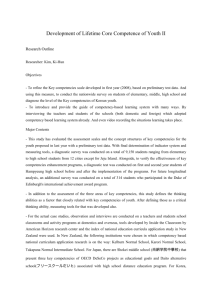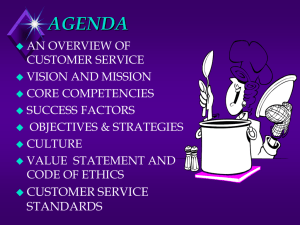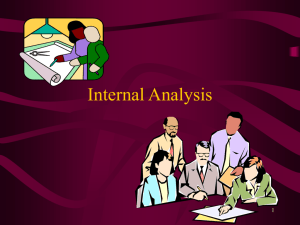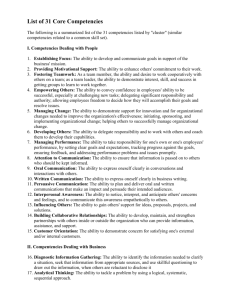Operations Strategy
advertisement
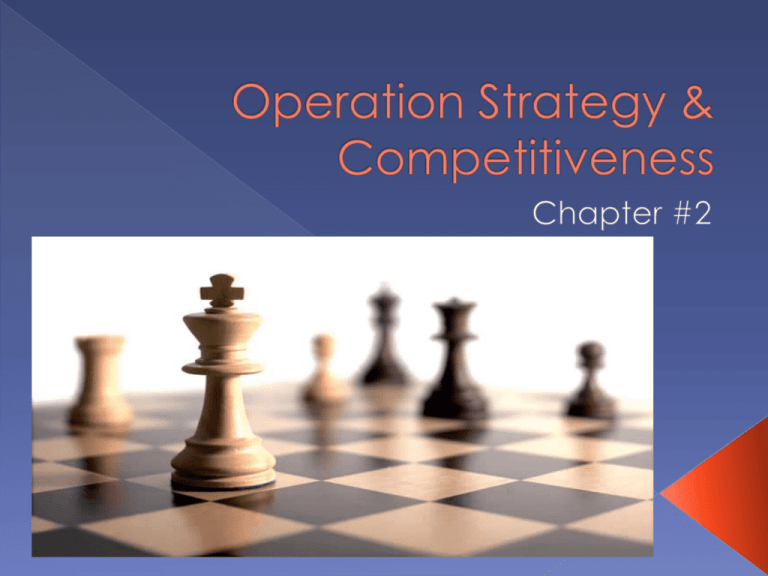
Relationship between Corporate Strategy & Operation Strategy Corporate Strategy Strategic Direction, Resources Organizational Process & Coordination to Produce Good & Services Operations Strategy Corporate Strategy consists of the decision made by the Top management regarding issues that effect the long-term survival and growth of the firm. It describes the future course of action the firm needs to adopt for long term success. Corporate strategy provides an overall direction that serves as the framework for carrying out all the organization's functions. Specifies the means by which operations implements corporate strategy and helps build a customer-driven firm. Operations strategy links long term and short term operations decisions to corporate strategy. Operations strategy helps the firm to be competitive and to improve its performance and profitability. Corporate Strategy • Environmental scanning • Core competencies • Core processes • Global strategies Market Analysis • Market segmentation • Needs assessment Competitive Priorities • Cost • Quality • Time • Flexibility New Service/ Product Development • Design • Analysis • Development • Full launch No Yes Performance Gap? Operations Strategy Decisions • Managing processes • Managing supply chains Figure 1.5 Competitive Capabilities • Current • Needed • Planned Please see page 50 (book-1)for details Environmental scanning (SWOT) Developing core competencies Core competencies refer to unique resources and strengths that an organization’s management consider when formulating strategies. These competencies include: 1. 2. 3. 4. Workforce Facilities Market and financial know-how Systems and technologies Developing core processes Global strategies Strategic Alliances Market Definition – STP decisions Needs assessment › Service or product needs › Delivery system needs › Volume needs › Other needs Please see page 53-56 (book-1)for details TABLE 1.2 | DEFINITIONS, PROCESS CONSIDERATIONS, AND EXAMPLES OF COMPETITIVE PRIORITIES COST Definition Process Considerations Example 1. Low-cost operations Delivering a service or a product at the lowest possible cost Processes must be designed and operated to make them efficient Costco 2. Top quality Delivering an outstanding service or product May require a high level of customer contact and may require superior product features Ferrari 3. Consistent quality Producing services or products that meet design specifications on a consistent basis Processes designed and monitored to reduce errors and prevent defects McDonald’s 4. Delivery speed Quickly filling a customer’s order Design processes to reduce lead time Dell 5. On-time delivery Meeting delivery-time promises Planning processes to increase percent of customer orders shipped when promised United Parcel Service (UPS) 6. Development speed Quickly introducing a new science or a product Cross-functional integration and involvement of critical external suppliers Toyota QUALITY TIME TABLE 1.2 | DEFINITIONS, PROCESS CONSIDERATIONS, AND EXAMPLES OF COMPETITIVE PRIORITIES FLEXIBILITY Definition Process Considerations Example 7. Customization Satisfying the unique needs of each customer by changing service or products designs Low volume, close customer contact, and easily reconfigured Ritz Carlton 8. Variety Handling a wide assortment of services or products efficiently Capable of larger volumes than processes supporting customization Amazon.com 9. Volume flexibility Accelerating or decelerating the rate of production of service or products quickly to handle large fluctuations in demand Processes must be designed for excess capacity Coca cola Design Analysis Development Full Launch Please see page 62 (book-1)for details TABLE 1.3 | OPERATIONS STRATEGY ASSESSMENT OF THE BILLING AND PAYMENT PROCESS Competitive Priority Measure Capability Gap Action Low-cost operations $0.0813 $17,000 0.90% Acceptable No action 0.74% Acceptable No action 48 hours Acceptable No action 98% Consistent quality Delivery speed Volume flexibility Cost per billing statement Weekly postage Percent errors in bill information Percent errors in posting payments Lead time to process merchant payments Utilization Target is $0.06 Target is $14,000 Too high to support rapid increase in volumes Eliminate microfilming and storage of billing statements Develop Web-base process for posting bills Acquire temporary employees Improve work methods › Organizational processes: Point-to-point route system rather than hub-andspoke design used by others. Service to 57 cities in 29 states with average trip of 500 miles Operating costs kept low through the use of 737 aircrafts, and limited services (no meals). Minimizing time span from landing to departure. Operating business at very low costs. › Coordination of Activities Simplification of functions Coordination among various dept. to deliver ontime service. Customer facilitation and easy access. › Organizational processes: $2 billion company with 924 stores in 31 countries Production of 12,000 apparel styles each year. Each is available in store in four weeks. Renews nearly half their stock every two weeks. Have more than 200 designer and produce two third of it’s clothes in company-owned facility in Spain. Hi-tech computer guided manufacturing and facilities. Skills of unique design team. › Coordination of Activities Cross functional coordination in new product development. Short time span between idea and their transformation into stores. › Organizational processes: More than10,000 store in 28 countries with average growth in profits is 30% per year. Secrets is their operations & service strategy. Supply of world famous coffee powder comes directly from Java, Indonesia through an effective supply chain. Quality is maintained in all stores worldwide with standardized procedures and strong customer feed back system. Wide range of products including a variety of exotic coffee, cappuccino, espresso as well as sandwiches, pastries, desserts even a music CDs of pop stars and internet facilities. Services include order and payment via phone and Starbucks web site and automated espresso machines. Company uses cluster store strategy in populated areas, e.g. there are 124 stores in just Manhattan area, New York.

